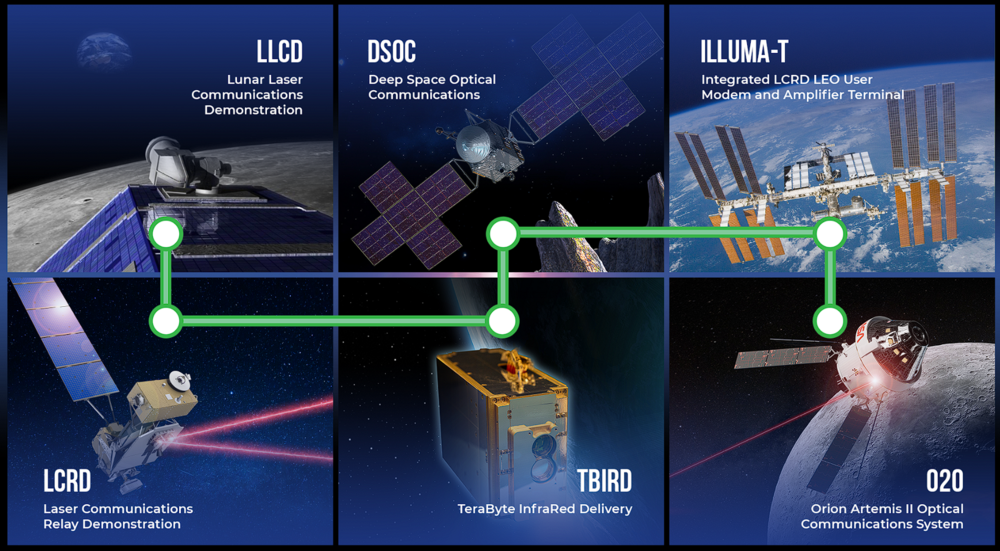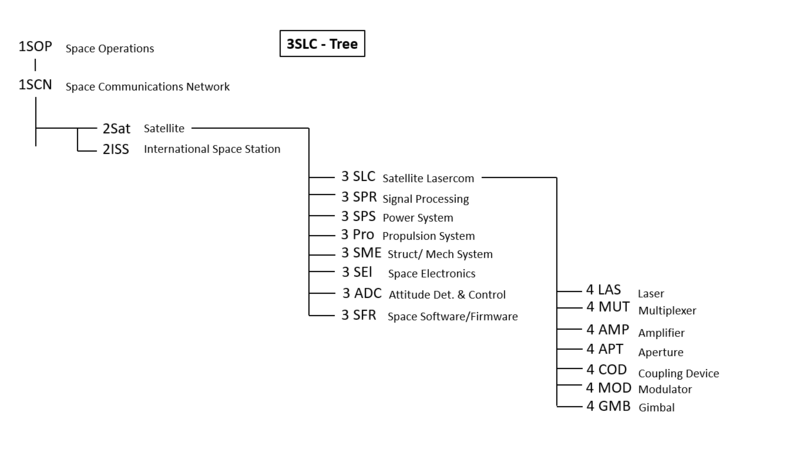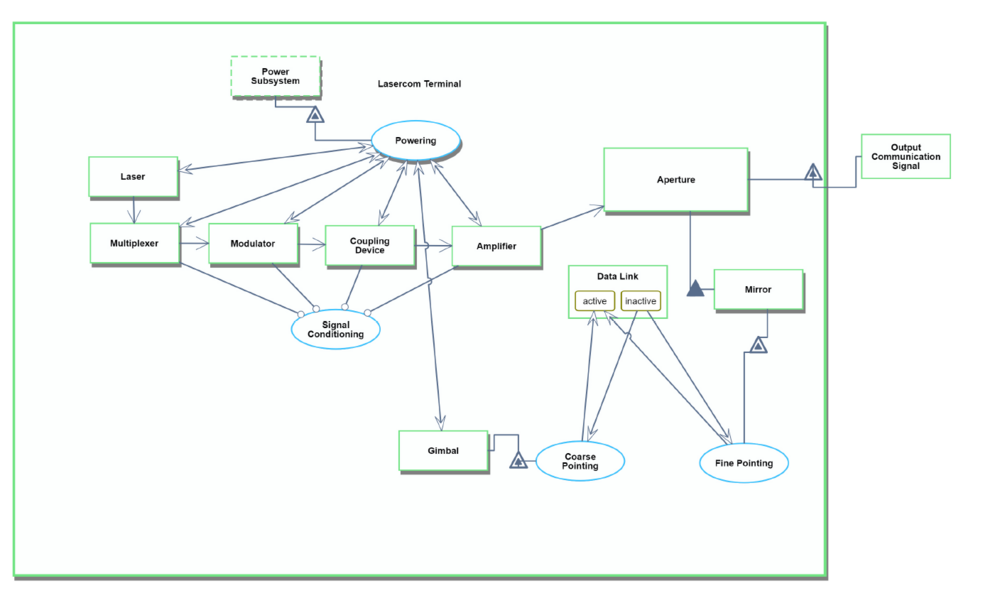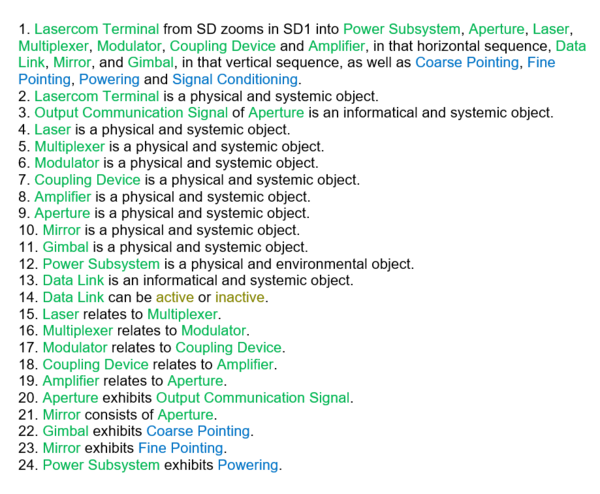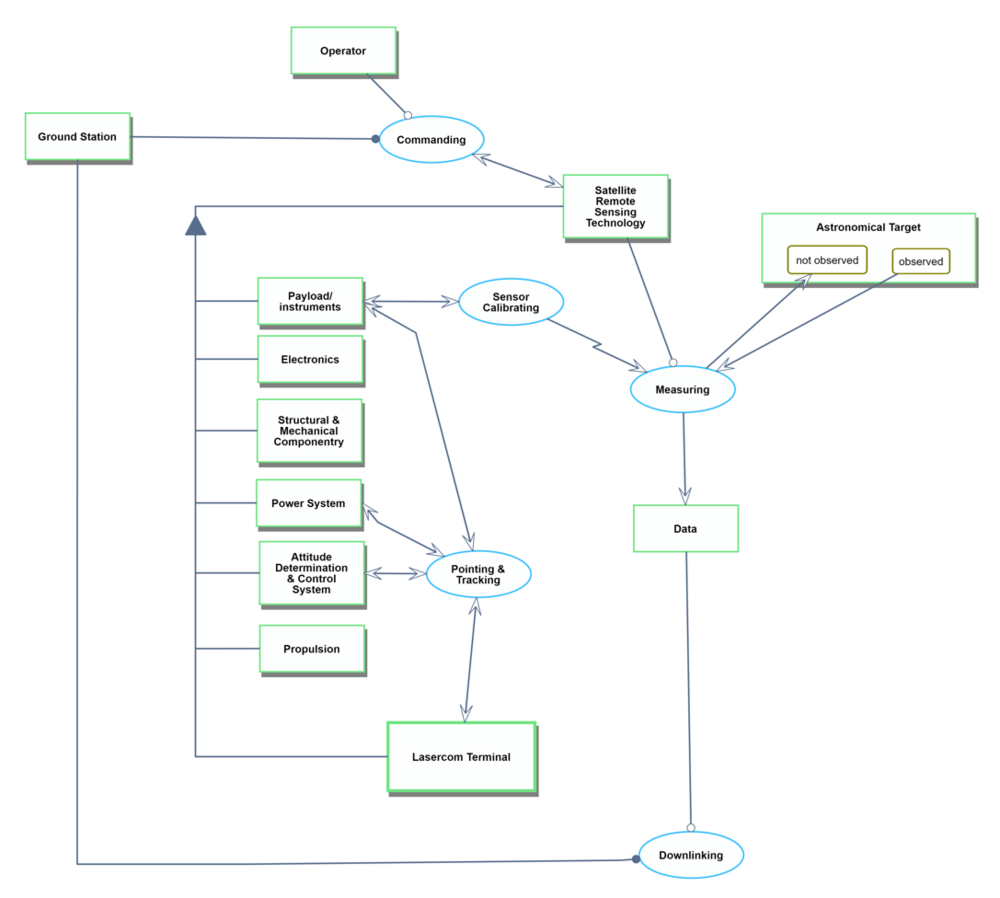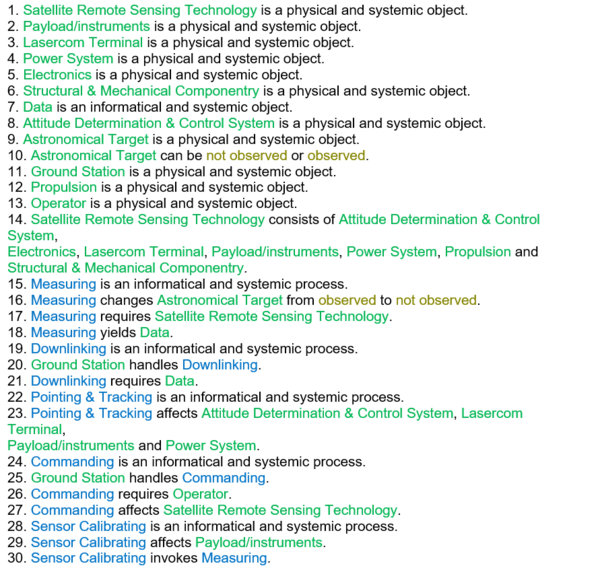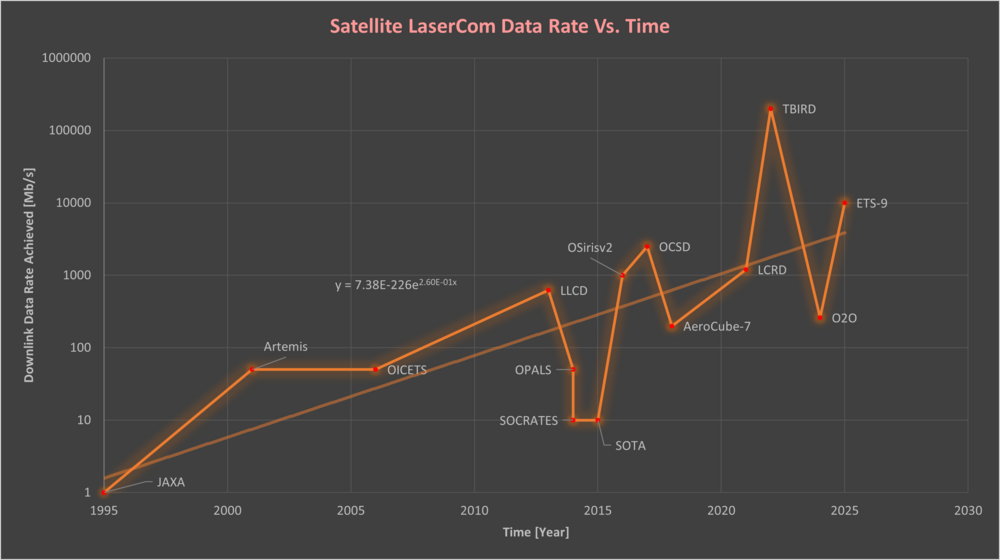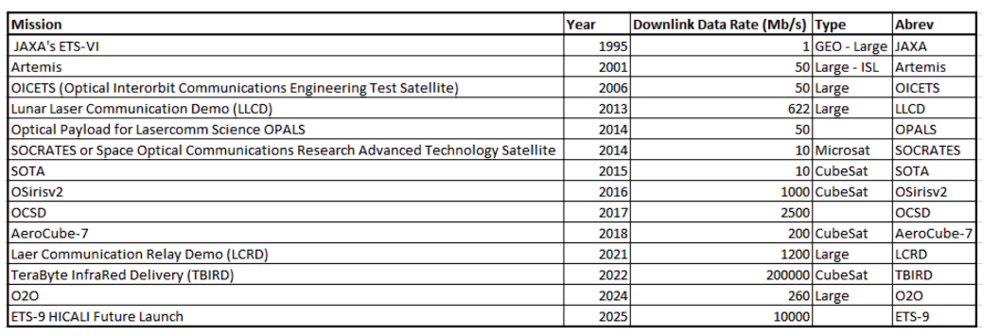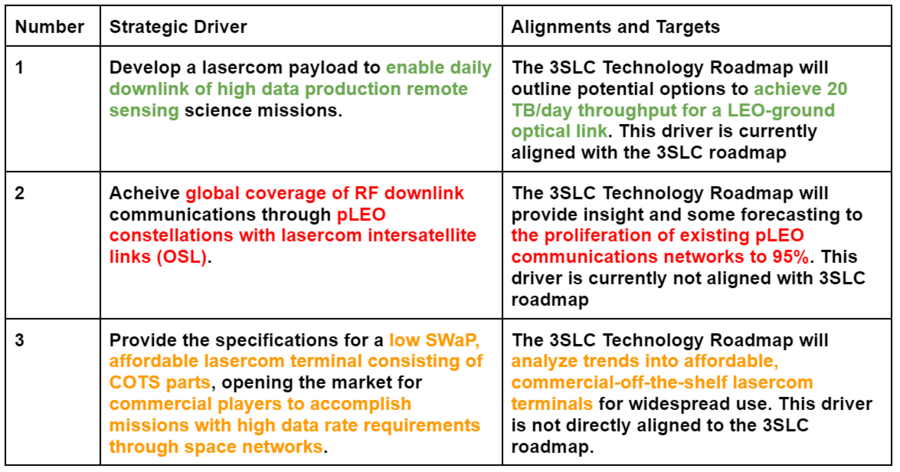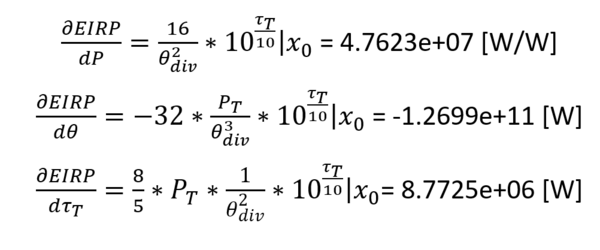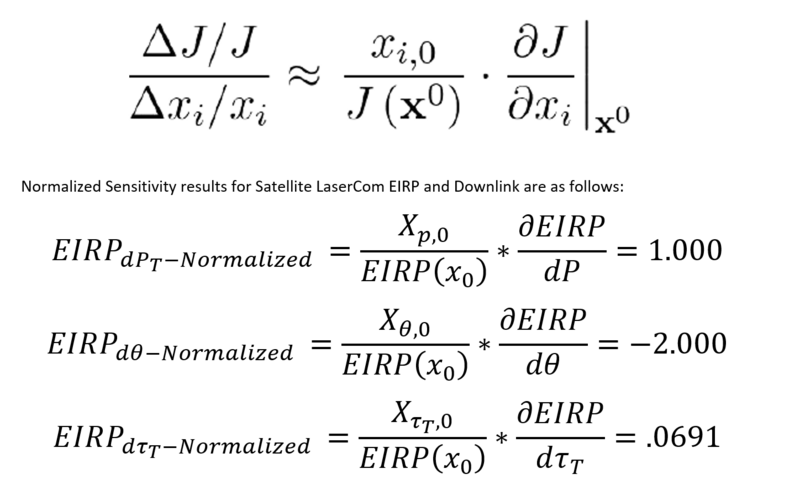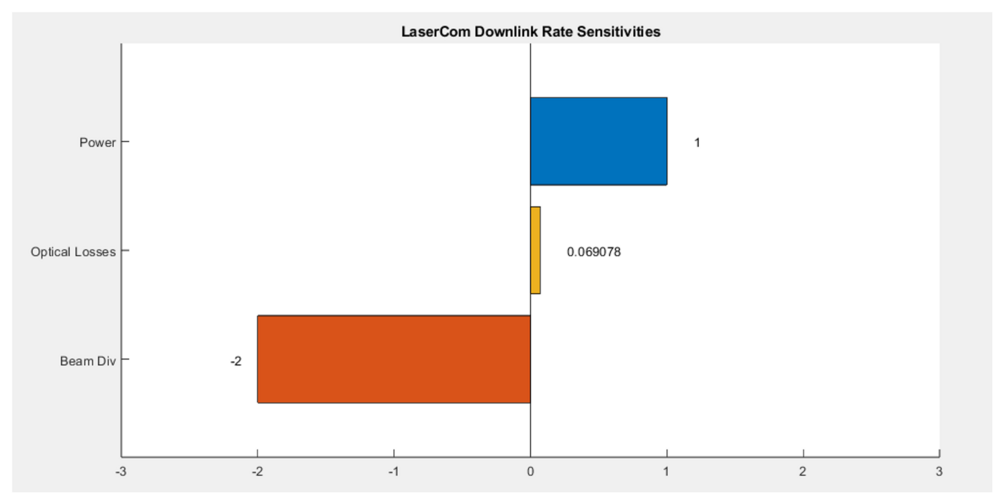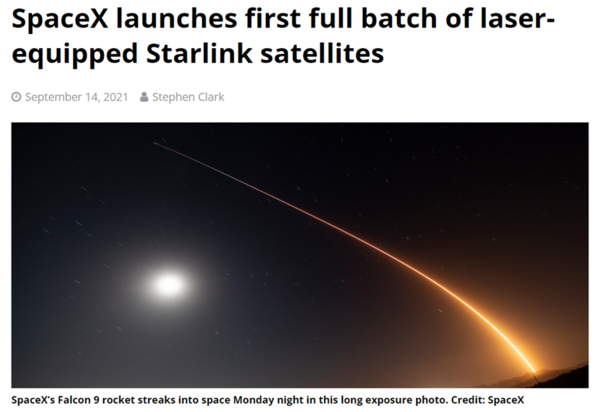Difference between revisions of "Satellite Lasercom"
| Line 63: | Line 63: | ||
==Alignment with Company Strategic Drivers== | ==Alignment with Company Strategic Drivers== | ||
The table below outlines high level satellite laser communication strategic drivers and their alignment with the 3SLC Technology Roadmap: | |||
[[File:3SLC_DriverTable.png|900px]] | |||
As mentioned throughout the 3SLC roadmap, the continued advancement of satellite lasercommunication capabilities will enable entirely new markets of work. One prevalent application is the downlink of data from remote sensing platforms on orbit. NASA Surface Waterand Ocean Tomography (SWOT) launched in late 2022 generates roughly 20 TB of data per day. Current RF and even lasercom communications capabilities cannot support the daily downlinks of this size, but it serves as a target point for future design. The driver can be split into two targets: one being the physical upscaling of current technology while the other is more aligned with advancing current data rate capabilities. For the former, we assume TBIRD capabilities at 4.8 TB data throughput per day from Paper 2 in the Key Publications section (this encapsulates pass window timing, data rate, and losses). As SWOT is a large class satellite, one could formulate the idea of stacking 4 or 5 TBIRD-like terminals on the bus to transmit down all data generated per day. | As mentioned throughout the 3SLC roadmap, the continued advancement of satellite lasercommunication capabilities will enable entirely new markets of work. One prevalent application is the downlink of data from remote sensing platforms on orbit. NASA Surface Waterand Ocean Tomography (SWOT) launched in late 2022 generates roughly 20 TB of data per day. Current RF and even lasercom communications capabilities cannot support the daily downlinks of this size, but it serves as a target point for future design. The driver can be split into two targets: one being the physical upscaling of current technology while the other is more aligned with advancing current data rate capabilities. For the former, we assume TBIRD capabilities at 4.8 TB data throughput per day from Paper 2 in the Key Publications section (this encapsulates pass window timing, data rate, and losses). As SWOT is a large class satellite, one could formulate the idea of stacking 4 or 5 TBIRD-like terminals on the bus to transmit down all data generated per day. | ||
Revision as of 01:59, 2 November 2023
Technology Roadmap Sections
- Technology Roadmap Identified as 3SLC - Satellite Laser Communication
This indicates a Level 3, Individual-Technology Level Roadmap
Roadmap Overview
Satellite Laser Communication (LaserCom) is a method of transferring data through an optical link using an onboard high-power laser system. This breaks from the historically standard Radio Frequency (RF) communication that has been used for satellites uplink and downlink since their inception. While a modern day RF communication link is considered high performing in the 100 - 500 MegaBit per second (Mbps) downlink data rate, an optical link can outperform this by up to 4 orders of magnitude. The TeraByte InfraRed Delivery (TBIRD) from NASA and MIT Lincoln Labs was able to demonstrate a sustained downlink of up to 200 Gbps in 2023. Lasercom data transfer may occur via uplink: ground station to satellite, downlink: satellite to ground, or intersatellite links: satellite to satellite. However, this technology is not without its challenges and limitations. Namely, a direct and accurately pointed path is required from lasercom source to its destination terminal in order to establish a valid link. In high orbital period orbits, such as LEO this may only allow for a link lasting several minutes per period. However, even with this limitation Lasercom technology allows vastly higher communication data rates and total information transfer at 10-100x that of the more conventional radio frequency communications.
How it works: Lasercom utilizes the ability to create oscillations in light waves in lasers to pack a high data volume into the data beam waveform. In its simplest form, information is transmitted by modulating light and broadcasting it over some medium (wire or air). Following this logic, we understand the driving physical limitation is the frequency of the light; how much information can be encoded in modulation in a unit time. The higher the frequency of the light used, the faster the signal can be modulated and the throughput is increased. The defining disruptive aspect of optical communication is exactly this: a fundamental shift along the electromagnetic spectrum from radio waves to higher optical frequencies, yielding much larger data bandwidth possibilities.
Advancement and proliferation of optical communication in space has enabled new capabilities that were previously not feasible due to data bottlenecking. As seen in the 2EOS roadmap, Earth observing imaging platforms are increasing in both spatial and spectral resolution. A key example is the Hyperspectral Imager Suite (HUSI) hosted on the ISS, which currently generates 300 GB of data per day. At this rate, the ISS cannot wirelessly downlink the imagery and data is currently transferred through hard drives on cargo ships! Current technology is also moving towards proliferated sensors rather than a few larger imagers, all greatly increasing the amount of raw data that needs to be transmitted to ground stations for processing and analysis. With all these trends, conventional RF communications can only be pushed so far and the need for lasercom terminals becomes apparent and necessary. Some RF transceivers have achieved appreciable data rates, such as the Integrated Solar Array and Reflectarray Antenna (ISARA) in 2017 at 100 Mbps, and some transmit only payloads can exceed that (Syrlinks EXC27 in 2015 at 140 Mbps), but they reach a practical limit in terms of SWaP when hosted on small sats. Optical payloads have steadily increased in proven data rates, from the JAXA ETS-VI at in 1995 1 Mbps, to Lunar Laser Communication Demo in 2010 at 622 Mbps, and more recently the Laser Relay Communication Demo in 2019 at 1.2 Gbps. This progress has recently culminated in the groundbreaking 200 Gbps link achieved by the NASA/MIT LL TeraByte InfraRed Delivery (TBIRD) lasercom terminal during a May 2022 flight test.
NASA's Official Laser Communication Relay Roadmap
Design Structure Matrix (DSM) Allocation
The 3SLC-Tree that can be extracted from the DSM shows that Satellite Lasercom (3SLC) is a Individual Level Technology that is a part of a larger Satellite (2SAT) Technology that lives within the highest level Technology classifications of Space Operations (1SOP) and Space Communications Network (1SCN). Many other satellite Subsystems exist at level 3 alongside Satellite Lasercom (3SLC) and comprise the satellite. Furthermore, many individual technologies serve enabling technologies to Lasercom at Level 4. This tree is highlighting those specific technologies for LaserCom and not all of the level 4 technologies that are necessary for other satellite subsystems.
Roadmap Model using OPM
Object-Process-Diagrams (OPD) of the 3SLC roadmap is provided in the figure below. The first diagram captures the main object of the roadmap (Lasercom Terminal) and it's enabling technologies and operational interactions. A higher level OPD is also included here to explain how the Lasercom Terminal fits and interacts at the Satellite Level (Satellite Remote Sensing Technology).
Figures of Merit
The driving Figure of Merit for lasercom is data rate, particularly the satellite downlink data rate in which the satellite sends information it has collected to the ground station on Earth. A key motivator for pursuing the development of Lasercom technology is to create higher throughput data links in space, beyond what has been available through traditional radio frequency communications. Lasercom allows for a drastic multiplication of downlink data rates, for example a satellite operating at a ~100 mbps downlink is on order for a high performance RF DL link on a large satellite in the X-band and there are plans to attempt a 2 Gbps X-band link, while NASA and MIT Lincoln Labs TBIRD 6U CubeSat has used lasercom to demonstrate a 200 Gbps downlink. Albeit the comm window is much smaller as the satellite has much more precise pointing requirements and atmospheric conditions than RF comm payloads. Even amongst this more stringent communication window lasercom allows a program to collect 10x - 100x more data that of RF based satellite systems: https://www.nasa.gov/communicating-with-missions/lasercomms/ This multi-order throughput result drives the case of lasercom in the data rate figure of merit. It proves lasercom systems to be highly desirable satellite capability as it has opened up what has historically been a bottleneck of satellite information transfer through restricted communication capabilities.
To ensure the viability of lasercom for use on small satellites, the overall Size, Weight, and Power (SWaP) of the terminal are important FOM. System weight has been trending down over the years from advances in shrinking powerful lasers. Roughly 10 years ago, terminals were upwards of 6 kg with the NICT SOCRATES device yet nowadays payloads are reaching sub-kilogram specifications (DLR OSIRIS4). On the other hand, power consumption values have been consistent over the past decade, varying from <5 W (NICT VSOTA) to 100 W (TBIRD). Power can vary depending on the underlying laser technology and transmitting scheme and is closely related to other FOM for the link budget that can extend beyond the transmitting lasercom terminal. These link budget parameters include beam width, pointing accuracy, receiving telescope diameter, receiving terminal sensitivity, and bit error rate. Utilizing a simple link budget equation that folds in all the ground terminal and lasercom system parameters, along with atmospheric attenuation factors, one can model communication performance. This output can be used to perform sensitivity analyses, understand which link geometries are possible with different technologies, and identify which aspects to improve through investments and R&D.
There has also been a significant increase in the capabilities of lasercom itself over the past 28 years, particularly in the achieved downlink data rate field. This progress has been captured (made by the date collected by the team) in the plot below, from various space missions since the first demonstration in 1995 from the JAXA program at 1 Mpbs to the 2022 demo of TBIRD at 200 Gpbs. Note the plot needs to be scaled logarithmically on the y-axis in order to distinguish the scale of progression in a readable format.
Modeling Rate of Improvement: While this timeline does a good job of creating an overall picture of the progress made in Lasercom both in rapidly improving optical data rate, dL, capabilities and increasing frequency of lasercom mission/investment of all satellite types, it is a bit tricky to model a representative δdL/δt due to the range of missions (demos, functional terminals, ect), satellite platforms, orbits and orbit/orbital altitude. Furthermore, the recent TBIRD demo is a serious outlier, it’s a promising sign for the future of lasercom and achievable dL, but it skews any form of least-squares regression fit to the model. However, an overall trendline and equation can be formatted pretty nicely to the logarithmic y-axis as shown below.
This trendline is modeled off of the exponential equation:
Since this is an exponential equation mapped to a logarithmic plot, it actually tracks well linearly and can be used to get a reasonable estimate of achieved average lasercom data rate at any given year. For example in 2016 it estimates a dL of 322 Mbps. Extrapolating this out to say 2030, yields an estimated average data rate of 1.23 Gbps. This is likely a reasonable estimate considering the TBIRD demo tech follow ups are looking to place many TBIRD-based terminals on future missions in the coming years.
Lastly, the derivative of Eq. 1 can be taken to get the instantaneous δdL/δt of this trendline. Calculating this derivative (which is actually super easily for e^x, just apply chain rule) yields:
This equation can be used to calculate the instantaneous rate of change for downlink data rate via lasercom at any given year. For example at year = 2022, δdL/δt is 398.4 Mbps, but as this technology continues to progress into the future at year = 2025, this model predicts δdL/δt to be 869.1 Mbps.
Alignment with Company Strategic Drivers
The table below outlines high level satellite laser communication strategic drivers and their alignment with the 3SLC Technology Roadmap:
As mentioned throughout the 3SLC roadmap, the continued advancement of satellite lasercommunication capabilities will enable entirely new markets of work. One prevalent application is the downlink of data from remote sensing platforms on orbit. NASA Surface Waterand Ocean Tomography (SWOT) launched in late 2022 generates roughly 20 TB of data per day. Current RF and even lasercom communications capabilities cannot support the daily downlinks of this size, but it serves as a target point for future design. The driver can be split into two targets: one being the physical upscaling of current technology while the other is more aligned with advancing current data rate capabilities. For the former, we assume TBIRD capabilities at 4.8 TB data throughput per day from Paper 2 in the Key Publications section (this encapsulates pass window timing, data rate, and losses). As SWOT is a large class satellite, one could formulate the idea of stacking 4 or 5 TBIRD-like terminals on the bus to transmit down all data generated per day.
For the technological development pathway to align with driver 1, one can instead back out the necessary data rate achieved by one module. Assuming a nominal daily pass window of 6 minutes, the required average data rate to transmit 20 TB of data is 926 Gbps. Using the FOM model from the FOM section of this roadmap, the predicted year to achieve this data rate is around 2046. It is worth noting this figure comes from a Moore’s Law assumption and it is projected the technology might follow a Pareto Front progression as the COTS industry catches up. This behavior could lead to near Tbps data rates by the early 2030’s.
Positioning of Company vs. Competition
Shown below is a technical specification overview for modern laser communication terminals designed for use on satellites, along with some example images.
Note: Entries containing "---" indicate the information could not be found through public access, whether it is intentionally withheld for existing systems or not yet determined for future systems.
The key FOMs in the table are data rate, power consumption, and terminal mass. Also included are relevant parameters beam wavelength, modulation scheme, link geometry, and platform class. The FOM section of this roadmap covers dedicated discussion and the modeling of data rate over time, the single most important FOM for characterizing the progress of lasercom technology. Interesting results can be seen when the data rate is analyzed in a coupled sense with the link geometry or platform class, yielding insight to specific mission areas and applications. As seen in the technical model section, data rate is proportional to the transmit power of the laser (P_t) and follows an inverse square relationship with distance (L) between the transmit and receive nodes. The first relationship influences the application space of hosting lasercom capabilities on smaller satellite platforms, showing the need for efficient laser technology in a SWaP constrained environment. The proposed CUBECAT terminal fills this niche with a small but relatively efficient laser for cubesat operations in LEO. CUBECAT makes highspeed lasercom accessible for smaller platforms that will be stationed close to Earth. On the other side of the tradespace is the HICALI technology, designed for GEO operations on a larger satellite platform. HICALI provides an impressive 10 Gbps data rate but draws the highest power of all mentioned terminals, due to its orbital distance being 100x that of LEO operations. Both HICALI and CUBECAT are important technologies for enabling high speed communications in vastly different application spaces.
Technical Model
To analyze the effects of various LaserCom FOMs on the critical Downlink Rate [mbps] metric, consider the Laser Link Equations and Effective Isotropic Radiated Power (EIRP) [W]. This term measures the laser power emitted from the satellite and is often defined (including at MIT) as EIRP = P*G, where P is transmitter power and G is aperture gain. These variables fold into the main dictating downlink date rate equation:
This sensitivity analysis will analyze the EIRP inputs to the downlink equation, while also folding in optical losses τT [db] and beam divergence angle Θdiv [rad], into the equation and create a modified EIRP equation:
This is the governing equation that will be analyzed and normalized to calculate the sensitivity of downlink data rate for inputs Power [W], Beam Divergence [rad], and Optical Losses [dB]. These sensitivities will be analyzed at vector x0, which is based on values of the FOM metrics pulled from the TBIRD Mission and are included below:
To start the analysis, the partial derivates relative to each of the variables whose sensitivity will be analyzed must first be taken and then analyzed for a non-normalized value at vector x0. Yielding the following results:
These are the instantaneous values partial differential values of each FOM being analyzed against EIRP, however they are currently non comparable values because they have not been normalized against one another. These must now be normalized based on the following mathematical definition (see full results in MATLAB output in appendix):
Plotting these results into a tornado chart, yields the following:
These results show the relative, normalized sensitivity of EIRP and therefore downlink data rate have to the Power, Beam Divergence, and Internal Optical Losses design FOMs. They show that of these figures of merit, the Downlink achieved is most sensitive to the beam divergence Θdiv. This value is negative because it varies inversely with EIRP, it also levies twice the effect of PT on EIRP, because the Θdiv term is squared. The other terms have positive normalized sensitivities because they vary more directly (in the numerator) with EIRP. The Laser Transmitter Power PT is the second most sensitive. The variation in internal optical losses τT has the least effect on EIRP and Downlink Rate when evaluated at design vector x0. This occurs mathematically because of its fractional dB value in the exponential term in the EIRP equation. These sensitivity values and charts are particularly useful to informing the LaserCom terminal design. Pinpointing a minimal Θdiv and maximizing PT allows will allow the EIRP to reach a max and maximize the LaserCom terminal design all else equal. Some fine tuning can be done by keeping optical losses to a minimum, but shouldn’t lead the design effort as a primary target.
Financial Model
List of Demonstrator Projects
Key Publications, Presentations and Patents
Patent Review:
Patent 1: 20200169323
System And Method Of Satellite Communication
HO4B / H04L
This patent discusses the layering of data link and physical systems to achieve high data rate (1 Tb/s) lasercom links that are generalizable to space-space, space-ground, and ground-ground. An interesting aspect of this work is that the patent holder is Facebook Inc. (now Meta), and presented to have applications in global wireless internet coverage through a communication network consisting of optical links connecting satellites and ground stations around the Earth. Error correction processing is incorporated throughout the proposed transmit receive (TX/RX) terminal architecture, ensuring the high speed data links successfully transmit their designated information.
Patent 2: 20220303009
Free-Space Optical Communication System And Methods For Efficient Data Delivery
HO4B / H04L
This patent covers advances in the optimization of data links for space based laser communicatio, specifically from members involved with the TeraByte InfraRed Delivery lasercom module being developed at MIT Lincoln Laboratory. The work outlines the use of high speed optical modems with an automatic repeat request architecture that enables error-free 100 Gbps Low Earth Orbit to ground data links. A key aspect of the novelty and relevance of this patent to the field of lasercom is the automatic repeat request error checking algorithm, which utilizes a secondary, low data rate link to ensure sequential data chunks are properly received before reading in the next chunk. This removes the need for any operator in the loop and results in efficient, automatic data transfers during the overhead satellite pass.
Patent 3: 20150349881
CONTROL SYSTEM FOR MULTI-BEAM FREE SPACE OPTICAL ENDPOINT
H04B
This patent proposed an interesting lasercom architecture that leverages a plurality of devices for multiple communication link endpoints. The system utilizes mechanical steering of transceiver modules and active beam deflectors to track moving transmit/recieve terminals. The underlying engineering design found in the patent has many applications for ground based communications, while the novel tracking aspect can naturally be extended to space applications. This patent is relevant to satellite based lasercom by incorporating these mechanical features into ground stations that can more accurately track overhead satellite passes, acting as a secondary steering mechanism along with the bulk motion of the primary telescope.
Literature Analysis:
Guelman, M., Kogan, A., Kazarian, A., Livne, A., Orenstein, M., Michalik, H., and Arnon, S., “Acquisition and pointing control for inter-satellite Laser Communications,” IEEE Transactions on Aerospace and Electronic Systems, vol. 40, Jul. 2004, pp. 1239–1248.
Throughout this roadmapping, it has become prevalent that satellite lasercom requires great advances in low SWaP laser technology as well as controlled and precise spacecraft attitude control. A key difference between traditional RF communications and lasercom is the directionality. RF waves can be broadcast across +120 degrees FOV, easing requirements on bus pointing control during communication links. On the other hand, lasers will need thousanths or ten thousandths of a degree precision for pointing. This paper proposed a robust technique that relies on a gimbaled head to point the transceiver while a closed control loop works to alter the laser beamwidth and directionality through fine steering mirrors located in the optical assembly. This paper focuses on the application of this method to intersatellite communications, a necessary connection to enable networks like those covered in Patent 1. It is worth noting this paper is relatively old in the field being published in 2003, and the proposed architecture requires either an existing data link to close the loop and establish the data link, or the authors propose mounting retro-reflectors on the buses as a feedback mechanism to the partner satellite. That being said, this paper is still relevant due to its progress in intersatellite data links which are a key factor in the ever growing number of satellites in proliferated networks.
Riesing, K., Schieler, C., Bilyeu, B., Change, J., Keer, B., Tarif, A., Piazzolla, S., Wange, J., Robinson, B., Reeve, R., Horvath, A., Gilbert, N., and Garg, A., “Operations and Results from the 200 Gbps TBIRD Laser Communication Mission,” 37th Annual Small Sat Conference, Aug. 2023.
As mentioned in our roadmap and called out in review 1, the TeraByte InfraRed Delivery (TBIRD) lasercom module has revolutionized the field of satellite based lasercom. In its 2022 flight test, TBIRD exhibited a 200 Gbps data rate and 4.8 TB throughput. This data rate was a 2 order of magnitude improvement over the existing state-of-the-art LEO-ground data rate of 1 Gbps achieved by the DLR OSIRISv2 program in 2016. As discussed in Patent 2, TBIRD accomplishes this revolutionary performance with high speed optical modems and automatic repeat request error checking algorithms. This paper provides more detail into the 2022 flight test, paving the way for the community to continue towards Tbps data rate capabilities. As discussed in the paper’s intro, this data rate not only optimizes current communication needs, but enables completely new science missions that generate high volume data products such as hyperspectral imagers, synthetic aperture radars, and radiometers. TBIRD is a disruptive technology in its own field, creating access to new markets in space based remote sensing.
Boroson, D. M., Robinson, B. S., Murphy, D. V., Burianek, D. A., Khatri, F., Kovalik, J. M., Sodnik, Z., and Cornwell, D. M., “Overview and results of the Lunar Laser Communication Demonstration”, Free-Space Laser Communication and Atmospheric Propagation XXVI, 2014.
One key market that lasercom is poised to overtake conventional RF communications is that of deep space data links. This publication outlines the first successful two-way lasercom link between terminals across lunar orbit and on Earth, proving out technologies that will lead to even further data link distances to Mars and beyond. At a mission level, the relevance of this publication is profound in terms of establishing the data link, but one can zoom into the technologies and analyze all the progress needed to enable that success. The lasercom terminal in this mission utilized a 15 microradian communication beam that had to be steered to an ~80 cm square revecieving telescope 385,000 kilometers away! Combining orbital knowledge of the lunar satellite and extremely precise uplink acquisition method, the low rate uplink could be established and lead to the even more precise alignment of the transmit beam to the ground telescope.
In The Media
For the past three years, SpaceX has been integrating newer satellites into the StarLink pLEO constellation with up to four lasercom terminals to support intersatellite links (ISL). These optical links enable the rapid transmitting of information between satellite buses in the network, greatly reducing end-to-end latency. Currently, roughly 45% of the satellites in StarLink are equipped with lasercom terminals and that figure is expected to grow as more updated models join the orbit.
Technology Strategy Statement
References
[1]Williams, D., “RF and optical communications: A comparison of high data rate ... - core,” NASA Available: https://core.ac.uk/download/pdf/10536487.pdf.
[2]Schauer, K., “NASA Laser Communications Innovations: A timeline,” NASA Available: https://www.nasa.gov/missions/tech-demonstration/nasa-laser-communications-innovations-a-timeline/.
[3]“Laser Communications Relay Demonstration (LCRD) overview,” NASA Available: https://www.nasa.gov/directorates/stmd/tech-demo-missions-program/laser-communications-relay-demonstration-lcrd-overview/.
[4]“The nobel prize in physics 2023,” NobelPrize.org Available: https://www.nobelprize.org/prizes/physics/2023/press-release/.
[5]“9.0 communications,” NASA State of the Art Report Available: https://www.nasa.gov/smallsat-institute/sst-soa/soa-communications/.
[6]On-orbit demonstration of 200-Gbps laser communication downlink from ... Available: https://ntrs.nasa.gov/api/citations/20230000434/downloads/Schieler%20paper%20spie2023-tbird-v4.pdf.
[7]“Laser Communication in space,” Wikipedia Available: https://en.wikipedia.org/wiki/Laser_communication_in_space.
